Pablo Picasso (1881–1973) is regarded as one of the 20th century’s most innovative and productive artists. His impact on the art world is immense, and viewers worldwide are still enthralled by his work. Picasso, a Spanish native, had a lasting impression on contemporary art by experimenting with various artistic mediums and displaying extraordinary talent at a young age. Picasso was formally instructed as a young artist in Barcelona, where his creative career started. However, the pivotal moment in his career came with his early 20th-century relocation to Paris.
Immersed in the city’s thriving cultural environment, Picasso soon rose to prominence with avant-garde luminaries, including Georges Braque and Henri Matisse.
Picasso addressed human emotion, sexuality, mythology, and the human form via his visual language, which are significant topics in his work. His artwork reflects his intense involvement with the world around him; his paintings, sculptures, sketches, and ceramics are all infused with raw intensity and life.
Picasso created an astounding variety of works of art throughout his lengthy and productive career, many of which still impact viewers today. His famous pieces, such as “Les Demoiselles d’Avignon” and “Guernica,” bear witness to his creative brilliance and enduring influence. We’ll look at 10 of Picasso’s most well-known works, each providing a window into the artist’s limitless imagination and deep understanding.
Les Demoiselles d’Avignon (1907)
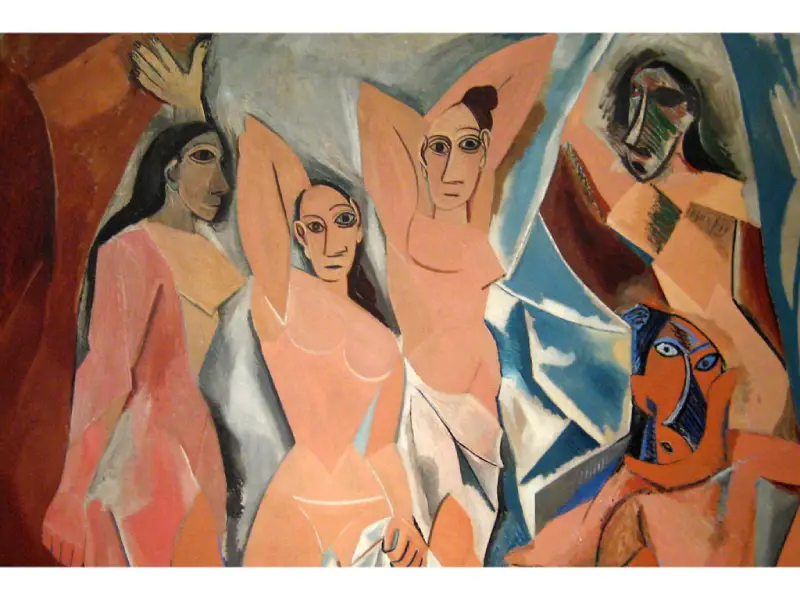
Created in 1907, “Les Demoiselles d’Avignon” is a well-recognized and groundbreaking picture by Pablo Picasso. This masterwork housed in the Museum of contemporary Art in New York City is regarded as a critical item in the evolution of the Cubist movement and contemporary art. Five nude female figures in a brothel scene are shown in the picture; each has angular, fractured outlines. Conventional ideas of beauty and representation are questioned by the aggressive and distorted portrayal of women’s bodies. Their mask-like characteristics on their faces allude to inspirations from non-Western creative traditions such as Iberian sculpture and African tribal art.
“Les Demoiselles d’Avignon” stands out for rejecting naturalistic portrayal and drastic break from traditional artistic methods. Picasso was investigating new ways of representing space, form, and perspective with his peers, seeking to convey multiple viewpoints simultaneously on the canvas. The artwork’s title alludes to Barcelona’s Avignon Street, well-known for its brothels. Picasso intended to explore deeper themes of sexuality, power, and primordial energy rather than just painting a prostitution scene. The ladies in the picture defy social norms and establish gender roles by radiating raw energy and independence.
Picasso’s “Les Demoiselles d’Avignon” presaged the rise of Cubism and was a significant change from his previous work. It acted as a spark for creative invention, encouraging the next generations of painters to play boldly and creatively with form, colour, and composition.
“Les Demoiselles d’Avignon” is still a foundational piece in art history today, appreciated for its audacity, uniqueness, and lingering impact. It is evidence of Picasso’s visionary genius and willingness to push the boundaries of artistic expression.
Guernica (1937)
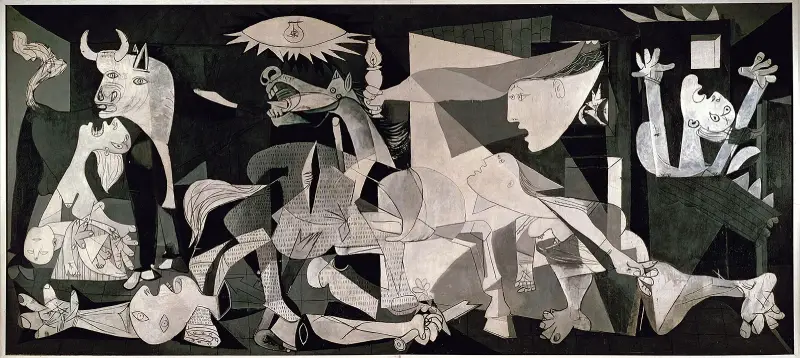
Pablo Picasso’s 1937 work “Guernica” is undoubtedly his most well-known and highly charged piece of art. This enormous picture, which is 3.49 meters (11 feet) tall and 7.76 meters (25.5 feet) broad, is kept at Madrid, Spain’s Museo Reina Sofía. It serves as a potent protest against war and a moving reminder of the horrors associated with hostilities.
The town of Guernica, located in Spain’s Basque Country, is the inspiration for the painting’s name. On April 26, 1937, German and Italian airplanes attacked the town during the Spanish Civil War. The nationalist troops of General Francisco Franco ordered the bombardment, which caused extensive damage and a high death toll among civilians.
The chilling “Guernica” painting, with its monochromatic black, white, and grey hues, portrays the atrocities of war. The composition is dominated by animals, objects, and deformed, agonized individuals writhing in agony and hopelessness. The picture is rife with symbolism, including reoccurring motifs like the flaming houses, the weeping woman clutching her dead child, and the injured horse.
Despite its disjointed and abstract manner, “Guernica” evokes empathy and condemnation for the agony that the innocent victims of war undergo. It also expresses a deep sense of grief and anger. Picasso turns the specific incident of the Guernica bombing into a universal statement against the senselessness and brutality of all wars via the use of symbolism and metaphor.
After being shown at the 1937 Paris International Exposition, “Guernica” immediately became well-known worldwide for its potent message and avant-garde aesthetic. It evolved into a catchphrase for anti-fascist movements globally and is still a timeless representation of harmony and defiance against injustice. As a tribute to Picasso’s steadfast dedication to utilizing art as a vehicle for political activity and social commentary, “Guernica” exists today. Generations of artists and activists are still motivated by it to challenge injustice and work towards a society that is more compassionate and peaceful.
The Weeping Woman (1937)
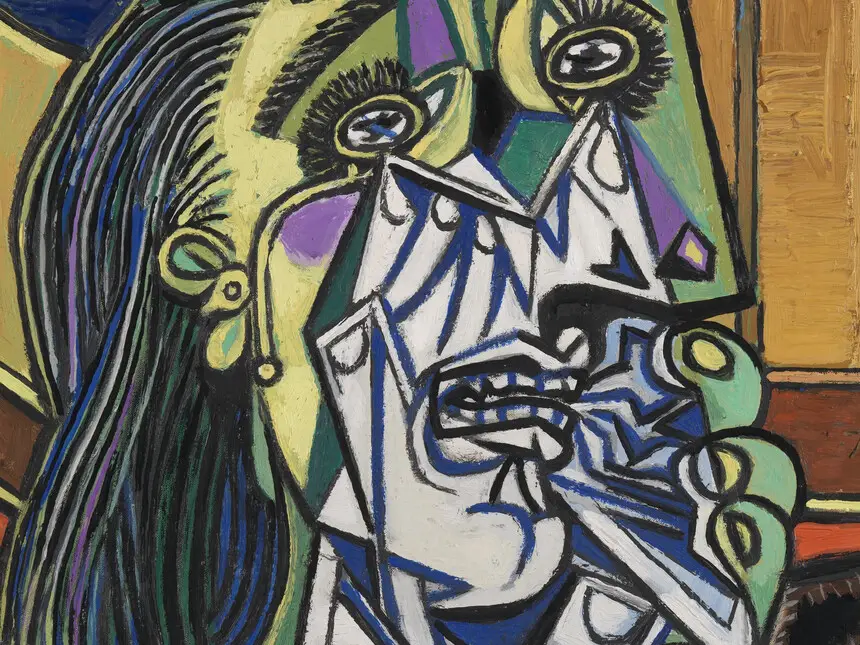
Pablo Picasso also produced the vital picture “The Weeping Woman” in 1937, the same year he finished his famous piece “Guernica.” It is a painting from a series influenced by the destruction of Guernica, a Basque village, during the Spanish Civil War. This picture shows a lady in extreme agony, with tears streaming down her cheeks and her features twisted in sorrow. Picasso’s Cubism is evident in the figure’s deformed and fractured shape, and the use of vivid colours and expressive brushstrokes further enhances the piece’s emotional impact.
The theme of “The Weeping Woman” is frequently seen to symbolize the sorrow that the Spanish people as a whole underwent during the Spanish Civil War, especially the women who suffered the loss of loved ones and the devastation of their communities. The figure’s sorrowful expression and haunted eyes evoke empathy and compassion from the viewer, serving as a poignant reminder of the human cost of war.
A significant feature of “The Weeping Woman” is the motif’s recurrence throughout Picasso’s work during this time. He depicted the sobbing woman in several ways, each with a unique emotional resonance and meaning. Picasso’s message about the tragedies of war and the eternal endurance of the human spirit is still relevant today, as seen by this repeat of the subject matter. Picasso’s painting “The Weeping Woman” is a potent example of his ability to communicate nuanced feelings and universal truths. It is both a timeless emblem of the human ability for empathy and compassion in the face of tragedy and a sad reminder of the long-lasting effects of violence on individuals and communities.
Les Noces de Pierrette (The Wedding of Pierrette) (1905)
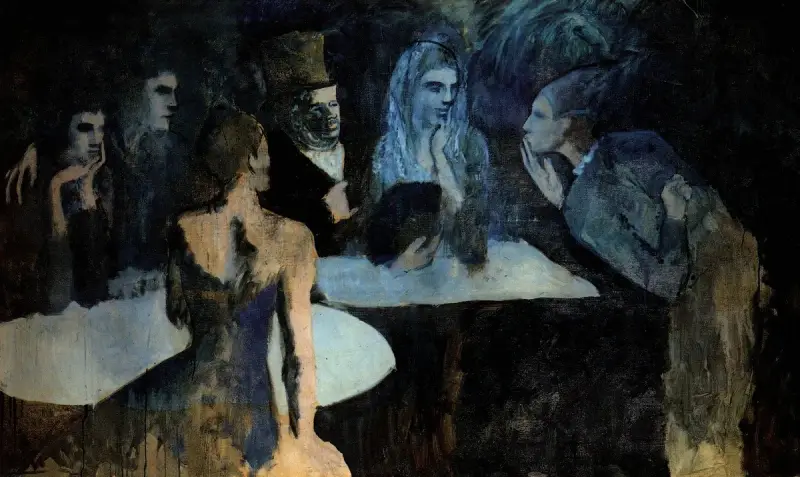
Pablo Picasso’s 1905 Blue Period work, “Les Noces de Pierrette,” or “The Wedding of Pierrette,” is considered one of his early masterworks. Picasso’s mental torment and the difficulties of people with low incomes are reflected in this period’s somber themes and mostly blue colour palette. A sad scenario with a young woman named Pierrette clothed in white against a somber blue background is shown in the picture. Her countenance is thoughtful, her eyes downcast, and she is shown as vulnerable and melancholy. Picasso is said to have drawn inspiration for the Pierrette figure from a real-life acquaintance, who may have been a friend or lover.
The painting’s title alludes to a wedding scene, yet the mood is everything from joyous. Instead, a feeling of quiet introspection and melancholy is typical of Picasso’s Blue Period works. The use of color, particularly the predominantly blue tones, adds to the overall mood of sadness and introspection. Many people see “Les Noces de Pierrette” as a reflection on the ephemeral nature of bliss and the inevitable nature of sadness. It displays Picasso’s obsession with themes of human misery, poverty, and loneliness, all present in his work at the time. The film “Les Noces de Pierrette” is praised for its eerie beauty and profound emotional depth despite its grim subject matter. It is a prime example of Picasso’s early compositional skill and capacity to arouse viewers’ strong feelings. The picture continues as a moving reminder of Picasso’s Blue Period’s long presence and influence on art history.
Girl Before a Mirror (1932)
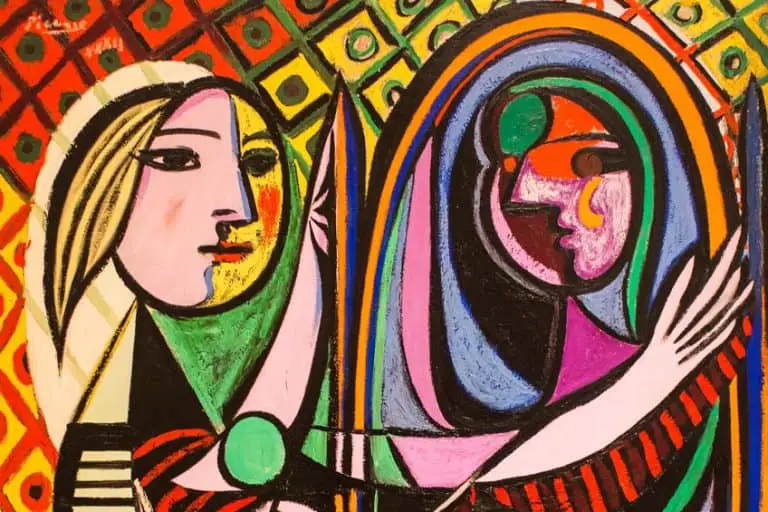
Pablo Picasso produced the important artwork “Girl Before a Mirror” in 1932, during the height of his Surrealist movement. This work of art, kept in the Museum of Modern Art (MoMA) in New York City, is well known for its intricate examination of perception, identity, and time. A young woman is shown in the painting staring into a mirror, her reflection displaying two different appearances. The woman has a youthful, radiant appearance on one side, with bold colors and elegant lines. On the other hand, her reflection has angular features and deeper tones, seeming damaged and shattered.
The woman’s reflection’s dual quality alludes to a contrast between the inside and outside beauty, innocence, experience, or aging process. Picasso invites viewers to consider the link between appearance and reality by incorporating symbolism, color, and shape into his compositions, which increase their complexity. Many believe that Picasso’s “Girl Before a Mirror” represents his obsession with the subconscious and the human psyche. A metaphor for reflection and self-examination is the mirror, and the woman’s shifting look represents the transience of beauty and the flexibility of identity.
Picasso’s inventive use of abstraction and distortion to portray psychological depth in this painting sets it apart from conventional ideas of portraiture. Viewers are prompted to discuss perception and self-awareness due to the composition’s dynamic tension created by juxtaposing conflicting parts. Picasso’s “Girl Before a Mirror” is a monument to his constant inventiveness and his capacity to push the limits of creative expression. It is still an enthralling and mysterious piece of art that audiences find compelling and challenges us to consider the intricacies of the human condition.
The Old Guitarist (1903)
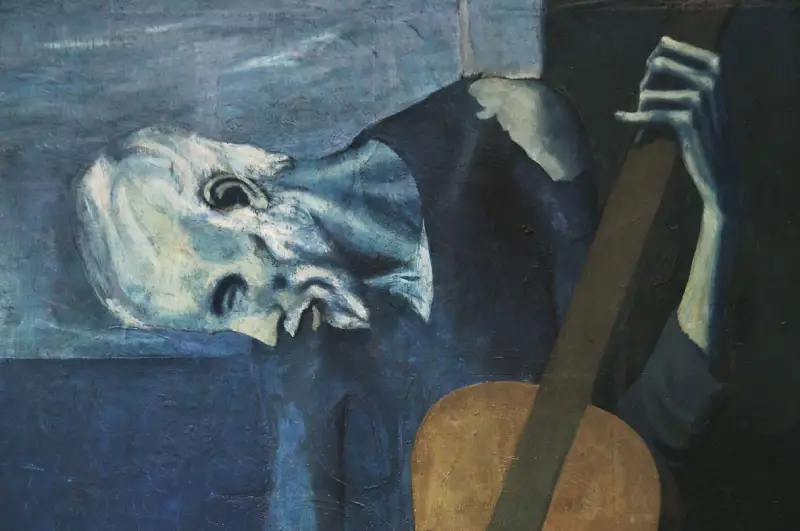
Pablo Picasso created the moving picture “The Old Guitarist” in 1903, the year of his well-known Blue Period. This period represents Picasso’s emotional problems and the condition of the oppressed and is distinguished by its gloomy color palette and themes of sorrow and poverty. An old, bent musician is shown in the artwork leaning on his guitar and resting it on his body. His gaunt figure and dejected countenance exude a deep sorrow and despair. The musician’s hands are seen gripping the guitar strings with power and tenacity despite his elderly age and physical weakness, demonstrating a solid commitment to his craft.
The painting’s heavy use of blue tones heightens the sensation of loneliness and misery while inspiring sympathy and empathy for the subject. The composition’s feeling of depth and emotional intensity are further highlighted by the striking contrast between light and shadow.
Many people see “The Old Guitarist” as a meditation on life in general and the difficulties faced by people with low incomes and those who are disenfranchised. Picasso asks spectators to ponder issues of desolation, loneliness, and the sublime force of art by depicting the musician as a lone person lost in his own world. “The Old Guitarist” is praised for its profound emotional impact and ageless beauty despite its somber subject matter. It displays Picasso’s early compositional expertise and his capacity to evoke profound emotion through his art. The painting remains a poignant reminder of the enduring legacy of Picasso’s Blue Period and its lasting impact on art history.
Seated Woman (1938)
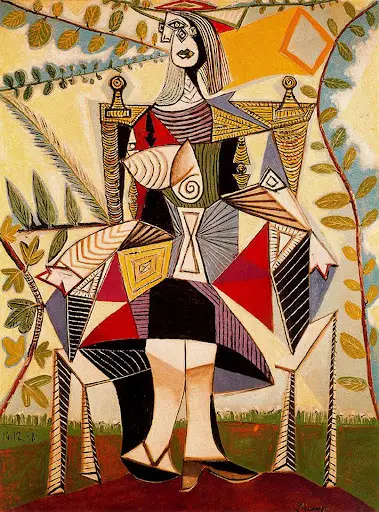
Pablo Picasso’s 1938 painting “Seated Woman,” commonly referred to as “Dora Maar Seated,” is a noteworthy piece of art. Picasso’s lover and accomplished artist and photographer, Dora Maar, is the artwork’s subject. Picasso’s unique technique and his ability to boldly and expressively capture the spirit of his subjects are best shown by this portrait. Picasso depicts Dora Maar sitting on a chair in “Seated Woman,” her figure depicted in a semi-abstract and deformed manner typical of his later works. Exaggerated features, vibrant colors, and vigorous brushstrokes give the image a sense of passion and vitality.
Dora Maar’s penetrating stare and enigmatic attitude convey a sense of power and resiliency, hinting at underlying emotions and complexities. Picasso’s portrayal of her as a multifaceted and independent woman reflects his deep admiration for her intellect and creativity. Picasso painted “Seated Woman” as one of several portraits of Dora Maar during their turbulent romance. These images capture the depth of their relationship and the complexity of their dynamic, bearing witness to the enormous influence Maar had on Picasso’s life and art.
Picasso’s continuous experimentation with shape and color, as well as his investigation into the human mind, are also reflected in this work. Picasso encourages viewers to ponder identity, perception, and the sitter’s inner world through his audacious and inventive approach to portraiture. “Seated Woman” is still a potent and moving portrait that exemplifies Picasso’s compositional skill and his capacity to convey his subjects’ essence in a way that is both fascinating and intensely intimate.
Les Saltimbanques (The Saltimbanques) series (1905)
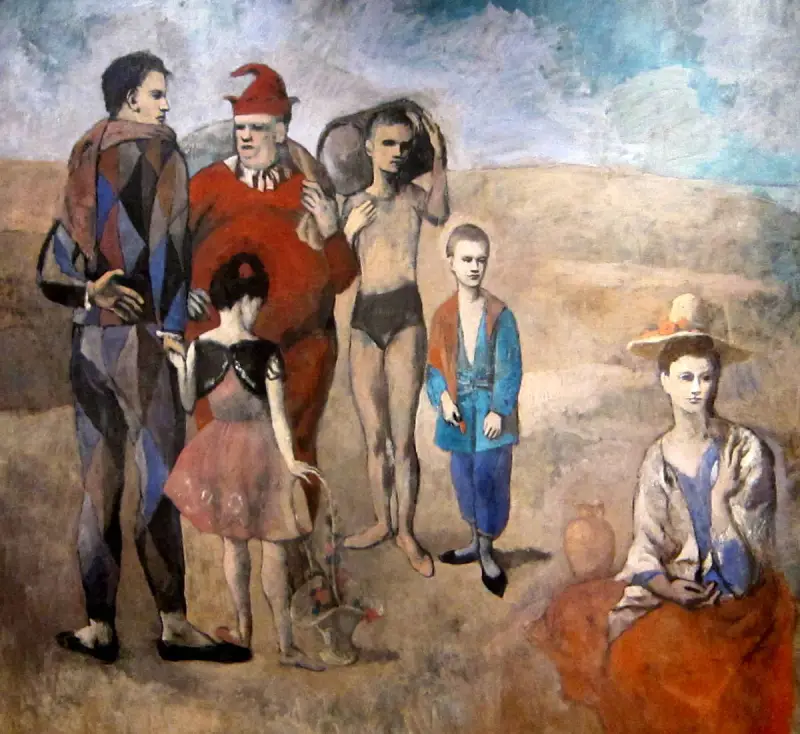
Pablo Picasso’s “Les Saltimbanques” series, sometimes called “The Saltimbanques,” is a notable collection of works executed in 1905. Notable for examining topics like transience, alienation, and the human condition, this series of paintings and drawings features circus performers, such as acrobats, clowns, and harlequins. During this time, Picasso was significantly impacted by the circus and its performers, drawing inspiration from their theatricality, sensitivity, and feeling of community. Picasso’s experiences as a struggling artist in Paris resonated with the Saltimbanques’ portrayal of a nomadic and marginalized existence.
Picasso captures the performers’ periods of quiet reflection during the circus’s extravaganza in the Saltimbanques series with empathy and compassion. To convey their life’s underlying melancholy and loneliness on the periphery of society, the individuals are frequently shown in subdued hues and solemn tones. “La Famille de Saltimbanques,” or “The Family of Saltimbanques,” is one of the most well-known pieces from the Saltimbanques series. It features a bunch of circus performers grouped in a depressing scene. A juvenile acrobat, a pierrot, a clown, and other individuals are included in the composition; everyone is engrossed in their thoughts and feelings.
The Saltimbanques series is praised for its universal themes of desire, belonging, and the pursuit of meaning and for its moving depiction of the human condition. Picasso asks spectators to ponder the intricacies of the human experience and the fleeting beauty of life via his delicate and sympathetic portrayals of the circus performers. Picasso’s career transformed the Saltimbanques series as he started to shift from the vivid colors and dynamic forms of his early works to those of his later Blue Period. Picasso’s ever-evolving creative perspective and his unwavering curiosity about the human drama playing out in front of him are both demonstrated by these paintings and drawings.
Three Musicians (1921)
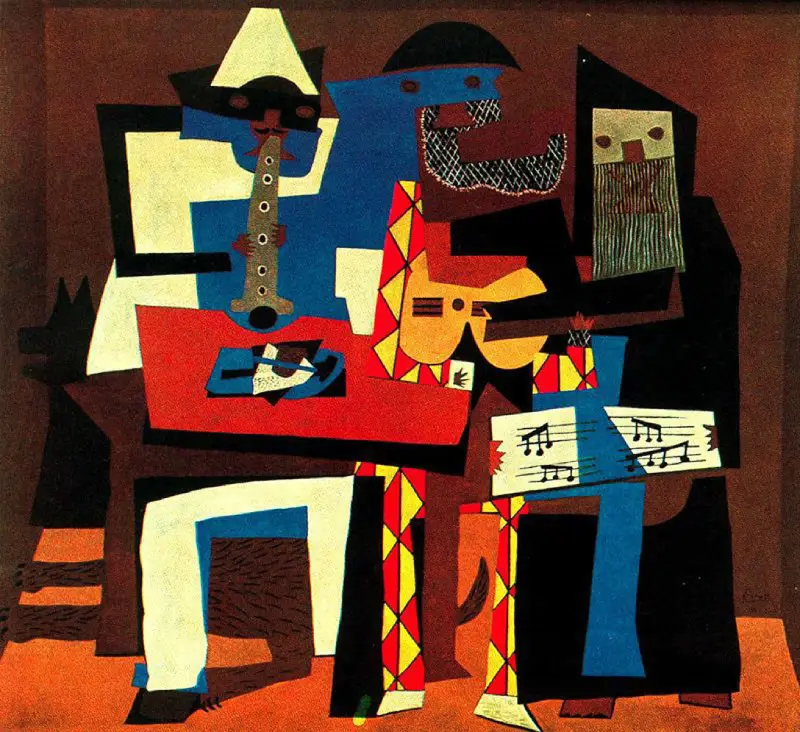
Pablo Picasso produced the well-known work “Three Musicians” in 1921, during the height of his Synthetic Cubist movement. This work of art is known for its avant-garde use of form, color, and composition and is kept in the Museum of Modern Art (MoMA) in New York City. The picture depicts three characters against a background of geometric forms and patterns, each carrying a musical instrument—a guitar, a clarinet, or a flute. Picasso’s Synthetic Cubist style is evident in the reduced shapes and vibrant, flat colors used to represent the figures. Even with the figures’ fragmentation and abstraction, small details like their clothing and the instruments they wield allow us to identify each of them individually. The composition is energetic and rhythmic, with the characters placed whimsically and harmonically.
Many people view “Three Musicians” as a celebration of imagination, teamwork, and the ability of art to cross boundaries. Together, the three musicians—representing various elements of musical expression—create a harmonic whole that is more significant than the sum of its parts.”Three Musicians” is noteworthy for acknowledging Picasso’s personal and creative inspirations. The figures, which include allusions to figures like Pierrot, Harlequin, and a monk, have been understood as a tribute to the Italian Commedia dell’arte heritage. Picasso’s preoccupation with primordial forms and his interest in African and Iberian art is further reflected in the geometric shapes and patterns in the backdrop. “Three Musicians” is proof of Picasso’s compositional expertise and capacity to push the boundaries of artistic expression. It remains a timeless and iconic work that inspires viewers with its vibrancy, creativity, and joie de vivre.
Woman in Hat and Fur Collar (1937)
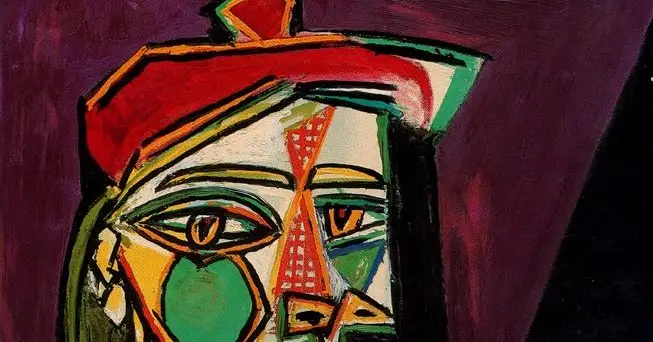
Pablo Picasso created the striking picture “Woman in Hat and Fur Collar” in 1937. Picasso’s masterwork, which is presently on display at the Kunstmuseum Basel in Switzerland, exemplifies his distinct method of portraiture and his capacity to boldly and expressively convey the spirit of his subjects. The picture depicts a woman sitting with her face inclined slightly to the side against a vivid blue backdrop. She is wearing a hat with a fur collar, framing her face and giving the composition a sense of refinement. Picasso’s signature geometric abstraction depicts the woman’s features, with solid lines and curves outlining her profile.
The woman’s individuality is communicated with warmth and closeness, even with the stylized portrayal. Her eyes convey a serene confidence and intellect, and her face is gentle. The color enhances the painting’s overall effect, especially the contrast between the woman’s warm skin and clothing tones and the painting’s deep blue backdrop. Many people believe that “Woman in Hat and Fur Collar” is a portrait of Dora Maar, a well-known artist and photographer who was also a lover of Picasso. However, Some art historians contend that the picture may be a composite image that combines aspects of many women from Picasso’s life.
“Woman in Hat and Fur Collar” is a tribute to Picasso’s command of form, color, and emotion, regardless of the sitter’s precise identification. With a sense of immediacy and vigor, the painting catches the essence of its subject and invites viewers to reflect on the complexity of human identity and emotion. Picasso’s “Woman in Hat and Fur Collar” is still regarded as a masterpiece because of its elegance, beauty, and timeless appeal. It is the perfect example of Picasso’s skill at capturing the inner essence of his subjects through portraiture, going beyond superficial likeness to give them a sense of intimacy and depth.
Conclusion
Pablo Picasso made valuable contributions to the field of art, and successive generations of artists and art lovers continue to feel his impact. Picasso’s career as an artist was characterized by ceaseless experimentation, limitless invention, and an uncompromising devotion to pushing the frontiers of creative expression, from his early investigations into conventional techniques to his pioneering discoveries in Cubism and beyond. Picasso painted a wide range of topics and subjects over his long career, ranging from the intensely personal to the profoundly universal. He explored the intricacies of the human condition, tackled social and political concerns, and engaged with the world around him in all its beauty and conflict via his paintings, sculptures, sketches, and ceramics.
To sum up, Pablo Picasso’s creative legacy goes beyond simple appreciation; it proves the art form’s eternal ability to arouse feeling, prompt thinking, and spur action. Picasso continues to inspire artists and enthusiasts worldwide with his enduring works of art and groundbreaking inventions, a constant reminder of the limitless potential of the human imagination and the never-ending pursuit of beauty, truth, and significance.








